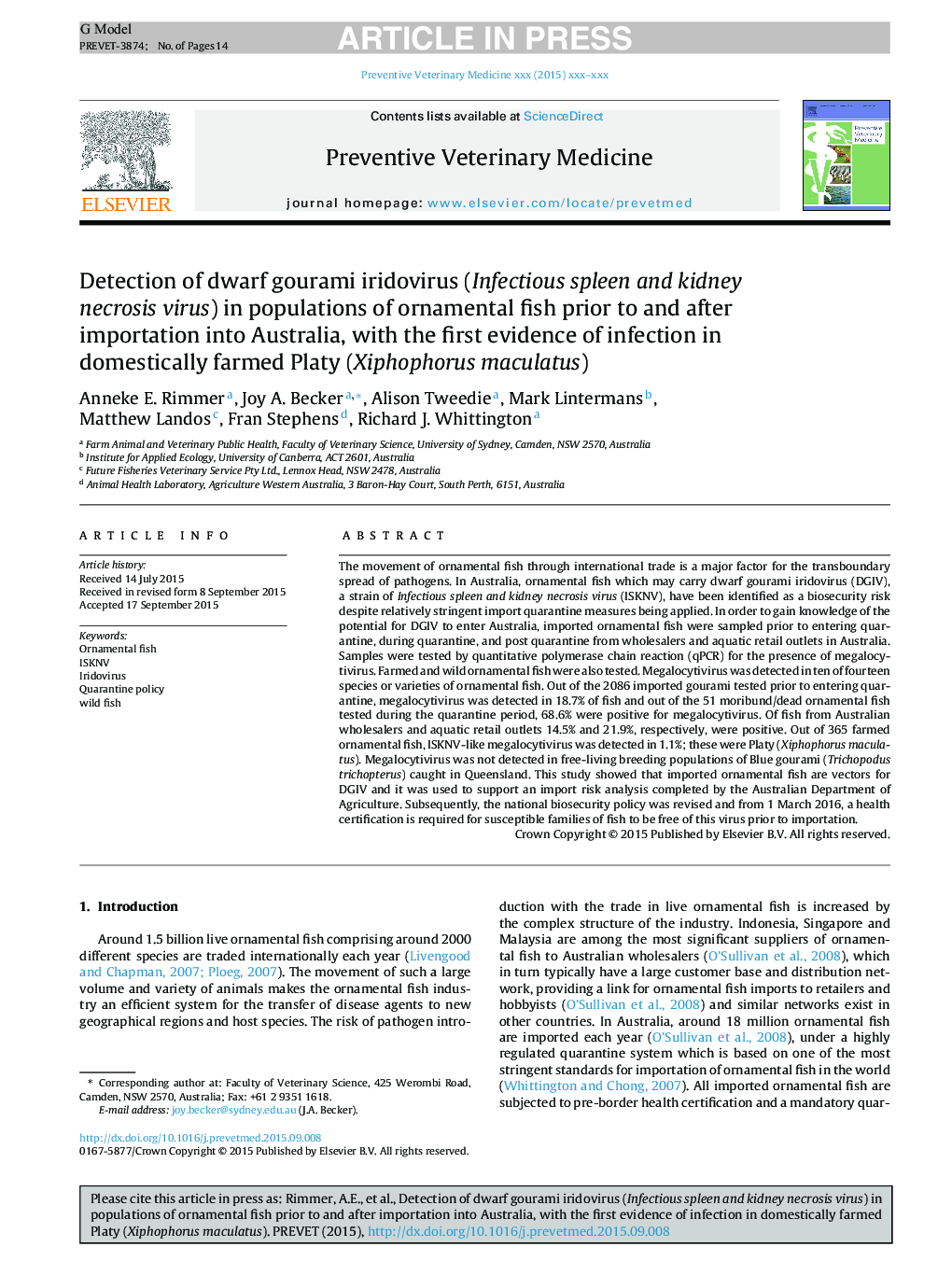| کد مقاله | کد نشریه | سال انتشار | مقاله انگلیسی | نسخه تمام متن |
|---|---|---|---|---|
| 5793087 | 1554166 | 2015 | 14 صفحه PDF | دانلود رایگان |
عنوان انگلیسی مقاله ISI
Detection of dwarf gourami iridovirus (Infectious spleen and kidney necrosis virus) in populations of ornamental fish prior to and after importation into Australia, with the first evidence of infection in domestically farmed Platy (Xiphophorus maculatus)
دانلود مقاله + سفارش ترجمه
دانلود مقاله ISI انگلیسی
رایگان برای ایرانیان
موضوعات مرتبط
علوم زیستی و بیوفناوری
علوم کشاورزی و بیولوژیک
علوم دامی و جانورشناسی
پیش نمایش صفحه اول مقاله

چکیده انگلیسی
The movement of ornamental fish through international trade is a major factor for the transboundary spread of pathogens. In Australia, ornamental fish which may carry dwarf gourami iridovirus (DGIV), a strain of Infectious spleen and kidney necrosis virus (ISKNV), have been identified as a biosecurity risk despite relatively stringent import quarantine measures being applied. In order to gain knowledge of the potential for DGIV to enter Australia, imported ornamental fish were sampled prior to entering quarantine, during quarantine, and post quarantine from wholesalers and aquatic retail outlets in Australia. Samples were tested by quantitative polymerase chain reaction (qPCR) for the presence of megalocytivirus. Farmed and wild ornamental fish were also tested. Megalocytivirus was detected in ten of fourteen species or varieties of ornamental fish. Out of the 2086 imported gourami tested prior to entering quarantine, megalocytivirus was detected in 18.7% of fish and out of the 51 moribund/dead ornamental fish tested during the quarantine period, 68.6% were positive for megalocytivirus. Of fish from Australian wholesalers and aquatic retail outlets 14.5% and 21.9%, respectively, were positive. Out of 365 farmed ornamental fish, ISKNV-like megalocytivirus was detected in 1.1%; these were Platy (Xiphophorus maculatus). Megalocytivirus was not detected in free-living breeding populations of Blue gourami (Trichopodus trichopterus) caught in Queensland. This study showed that imported ornamental fish are vectors for DGIV and it was used to support an import risk analysis completed by the Australian Department of Agriculture. Subsequently, the national biosecurity policy was revised and from 1 March 2016, a health certification is required for susceptible families of fish to be free of this virus prior to importation.
ناشر
Database: Elsevier - ScienceDirect (ساینس دایرکت)
Journal: Preventive Veterinary Medicine - Volume 122, Issues 1â2, 1 November 2015, Pages 181-194
Journal: Preventive Veterinary Medicine - Volume 122, Issues 1â2, 1 November 2015, Pages 181-194
نویسندگان
Anneke E. Rimmer, Joy A. Becker, Alison Tweedie, Mark Lintermans, Matthew Landos, Fran Stephens, Richard J. Whittington,